
“The promise of greatness I’m a helluva guy!
They gave me a roadmap; I looked at the wheel
And said ‘Wow . . . I don’t think I wanna drive!’”
-Three Guys . . .
The above quote is from the opening song of a favorite musical of mine. In the song, the performer comically laments that despite his enormous potential, he did not live up to his promise. I think it’s a theme that pretty much any grown-up can relate to—and something that kids and teens would be smart to avoid.
“Will You Still Need Me, Will You Still Feed Me, When I’m 34?”
It often surprises people when I inform them that I am 34 years old. I certainly don’t look or act 34, and my situation—having recently graduated college and just starting out in the business world—belies someone ten years younger. Personally, I don’t really feel like I’m anywhere close to my calendar age . . . except maybe on those occasional mornings when I wake up after sleeping wrong and my muscles remind me that I do actually have a 34-year-old back. The sands of time don’t lie—I am well into my fourth decade on this planet.

Without going too in-depth, my story is basically that I didn’t really know what I wanted to do with my life for a very long time. This caused me to shirk my tasks and responsibilities under the presumption that one day I would have an interest in doing them. At the time, this was great fun, as sleeping and playing computer games in lieu of working and going to school was far more entertaining. Over time, though, I noticed that my contemporaries were moving on to bigger and better things: high-paying jobs, spouses, and even families. By the time I realized that this was what I wanted for my life, a good chunk of time had passed. Thus, I am just now realizing the fruits of the labor that I should have performed years ago.
Don’t get me wrong—I love my life right now. I have a good job and great friends, and I am part of a TCG community devoted to a game that I thoroughly enjoy. In many regards, this is more than I ever wanted for myself. However, there are certainly occasions when I look back to “What Might Have Been.” I often wonder how different my life might have been if I had followed the more standard path of my peers.
However, I am pragmatic enough to know that it’s no good to cry over spilt milk (though you might think differently if you’ve ever heard any of my “bad beat” stories). My life, just like everyone else’s, is moving inexorably forward, and there’s nothing I can do to change what has happened. I can only hope to make the most of my tomorrows and leave my yesterdays where they belong: in the past.
Redemption, Like Lightning
Given my past experiences, I tend to feel a special kinship towards the Thunderbolts. While their story is perhaps a bit more extreme than my own, there are nevertheless some interesting parallels. Originally, a good chunk of the Thunderbolts’ members were villains of some variety. In Vs. System, this is exemplified by many of the Thunderbolts characters having different versions on the Masters of Evil team. Following the Onslaught saga and the supposed death of most of the Earth’s mainstream super heroes, Helmut Zemo organized the Masters of Evil into the faux-superhero team called the Thunderbolts. Zemo’s intention was for the Thunderbolts to gain the support and trust of Earth’s populace by acting as their protectors. Once the Thunderbolts had free rein, Zemo would use that privilege to grasp ultimate power. Now that’s evil!
Fortunately for the Earth, Zemo ran into a small problem: Most of the Thunderbolts preferred being super heroes to being super villains. This made it hard for Zemo to pull off his nefarious plan, as most of his teammates no longer had an interest in being nefarious. The long and short of it was that Zemo got the boot, and the former renegades became super heroes proper.
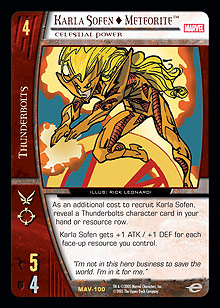 I came to the conclusion earlier this week that I really wanted to go for a deck theme involving the face-up strategy of the Inhumans. While the Inhumans team probably has enough power to make the deck work without outside help, I decided to look for any other cards or teams that might support this theme. I did a quick search on Dylan “DocX” Northrup’s Vs. System card search engine, searching for cards with the word “face-up” in their text. About three-quarters of the way through the search, I came across a card that jumped right out at me: Karla Sofen ◊ Meteorite, Celestial Power.
I came to the conclusion earlier this week that I really wanted to go for a deck theme involving the face-up strategy of the Inhumans. While the Inhumans team probably has enough power to make the deck work without outside help, I decided to look for any other cards or teams that might support this theme. I did a quick search on Dylan “DocX” Northrup’s Vs. System card search engine, searching for cards with the word “face-up” in their text. About three-quarters of the way through the search, I came across a card that jumped right out at me: Karla Sofen ◊ Meteorite, Celestial Power.
Now here was a card that I could really relate to. First and foremost, she’s on the Thunderbolts. For reasons previously discussed, this in itself had special meaning to me.* But beyond that, Meteorite is a character that never quite seemed to live up to her potential. One big hurdle was that the Thunderbolts characters only found a significant amount of play in two particular deck types: Faces of Evil and Thunderbolts Tactics. Because Faces of Evil relied so heavily on playing characters costing 3 or less (so as to gain the attack boost from Faces of Evil), the 4-drop Meteorite was too big to find a place in the deck. Thunderbolts Tactics, on the other hand, revolved around characters that had some sort of readying effect or attribute. Meteorite, while potentially very big, has no additional effect relating to her status as ready or exhausted. The simple truth is that Meteorite would really only ever have a chance to thrive in a deck devoted to having all of its resources face-up.
Now, what was I saying before? Oh yeah . . . I wanted to build a deck that thrived on having all of its resources face-up. Great Scott! The Inhumans have cards that facilitate having face-up resources, and Meteorite gets bigger for every face-up resource we control! Ladies and gentlemen, we have a winner! Meteorite is getting a chance to live up to her promise of greatness. We’re going to build an Inhumans deck focused on the “face-up resource” theme, and our star of the show will be none other than the Thunderbolt heroine, Meteorite.
The Build
Of course, we want to start things off with four copies of our featured card, Karla Sofen ◊ Meteorite, Celestial Power. Obviously, we are also going to have a strong complement of Inhumans characters to support our “face-up resource row” theme. However, considering that we have to have another Thunderbolts character card to reveal when we recruit Meteorite, we will need to have some representation from that team as well. The question is: Who do we want at certain drops?
For 1-drops, we’ll want four copies of Dallas Riordan, Mayoral Aide. Meteorite is obviously the deck’s lynchpin. However, Dallas Riordan also fits in nicely with the Inhumans in a couple of ways. First, she has concealed, which works well with Inhumans cards like Himalayan Enclave. Second, and perhaps more importantly, Dallas Riordan’s activated effect improves the cycling power of the deck and gives us another way to make cards like The Substructure effective. Given all that she adds to the flow of the deck and the fact that she is a much-needed Thunderbolts character, she is an obvious inclusion to the deck.
For 2-drops, we’re going all Inhumans. Our plays at this turn range from passive to aggressive. On the passive side, San is another great card for setting up our resource row. With a copy of The Substructure already in play, we can effectively use San to search out whatever location we want for later turns and put it into play immediately. Considering some of the powerful locations that we will have at our disposal, this will certainly be a powerful effect. Of course, if we don’t already have a copy of The Substructure available, San can search that out for our draw on turn 3. On the aggro front, Quicksilver, Inhuman by Marriage is a pretty easy choice for our deck. At an impressive 3 ATK / 3 DEF, Quicksilver can attack most 1- and 2-drops without fear of stunning back. If we fall behind early in the race for board control, Quicksilver’s ability to attack twice in a turn can even the odds in a hurry.
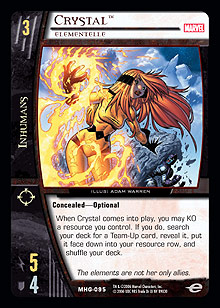 We have some toolbox choices for our deck in the 3-drop slot. Our Inhumans representative here is Quicksilver’s wife, Crystal, Elementelle. She is certainly respectable at 5 ATK / 4 DEF with range and concealed. However, much like San, her inclusion has to do with her ability to set up our resource row. Having the nifty ability to bring a team-up directly into play will come in handy on turn 4 when Meteorite comes out. This also saves our other search and cycling cards for other uses. Another 3-drop we’re going to play is a copy of Wolverine, Skrunucklehead. The logic for his inclusion is twofold. First, he is a viable search target on turn 3 when we aren’t able to search for an Inhumans character with Enemy of My Enemy. While he isn’t actually stamped with the printed Inhumans team affiliation, he still gets all of the Inhumans character benefits when he is in play. Secondly, his cosmic effect allows him to swing way up the curve. You might be concerned that since it is a cosmic—surge effect, he won’t ever get the chance to utilize that ability. If we take into account that the Inhumans team-up card Extended Family allows us to restore cosmic counters, however, then the chances of Wolverine becoming a 10 ATK beatstick become much greater! Finally, we have our obligatory tech card, the 3-drop Kang, Kang Cobra. It’s certainly nice that Kang has concealed to fit in the pseudo-hidden theme that we are incorporating into the deck, but the real reason for his addition is to keep power-up-based decks like Big Brotherhood and Good Guys from completely destroying us.
We have some toolbox choices for our deck in the 3-drop slot. Our Inhumans representative here is Quicksilver’s wife, Crystal, Elementelle. She is certainly respectable at 5 ATK / 4 DEF with range and concealed. However, much like San, her inclusion has to do with her ability to set up our resource row. Having the nifty ability to bring a team-up directly into play will come in handy on turn 4 when Meteorite comes out. This also saves our other search and cycling cards for other uses. Another 3-drop we’re going to play is a copy of Wolverine, Skrunucklehead. The logic for his inclusion is twofold. First, he is a viable search target on turn 3 when we aren’t able to search for an Inhumans character with Enemy of My Enemy. While he isn’t actually stamped with the printed Inhumans team affiliation, he still gets all of the Inhumans character benefits when he is in play. Secondly, his cosmic effect allows him to swing way up the curve. You might be concerned that since it is a cosmic—surge effect, he won’t ever get the chance to utilize that ability. If we take into account that the Inhumans team-up card Extended Family allows us to restore cosmic counters, however, then the chances of Wolverine becoming a 10 ATK beatstick become much greater! Finally, we have our obligatory tech card, the 3-drop Kang, Kang Cobra. It’s certainly nice that Kang has concealed to fit in the pseudo-hidden theme that we are incorporating into the deck, but the real reason for his addition is to keep power-up-based decks like Big Brotherhood and Good Guys from completely destroying us.
Turn 4 needs little explanation, as it features our theme card, Meteorite. Turn 5 has a couple of neat characters for our perusal. On the more aggressive front, we have Hawkeye, Leader by Example. In unison with Meteorite, this guy can be absolutely nuts. Considering that Meteorite will usually be big enough on turn 5 to swing up the curve and easily stun our opponent’s 5-drop, Hawkeye makes this attack quite favorable because Meteorite won’t even stun in the attack. This leaves our gigantic 11 ATK / 9 DEF 5-drop free to swing back down the curve at our opponent’s smaller characters. Of course, we aren’t always looking for sheer size at this point in the game. That’s why we also have Karnak at 5. Inasmuch as Hawkeye is powerful, Karnak is equally as subtle. Once he gains a cosmic counter, Karnak ensures that our smallest character in play will be capable of taking down our opponent’s largest character. Dallas Riordan may not look like much of a beater, but Karnak makes her 1 ATK more than a match for an opposing 6-drop’s 0 DEF!
Two 14 ATK characters comprise our selections at 6. For the Thunderbolts, we have the formidable Genis-Vell ◊ Photon. Sizable stats, flight, and range make Photon a pretty package already, but he also provides some utility for us in the early turns, giving us a moderate defense boost for our smaller characters. Being able to attack with Quicksilver and Wolverine without having to worry about them stunning back can reap benefits for us in later turns. A Thunderbolts 6-drop who doubles as a useful defensive pump—what’s not to love? Also at 6, we have the potentially game-ending Maximus the Mad. Where we might have once had to worry about problematic formations disrupting our attacks and creating reinforcement avenues, Maximus eases our concerns by forcing our opponents to move all of their characters to the front row. Without any help from the support row, we are free to send our sizable characters after our opponent’s incapacitated board. Madness you say? Methinks not!
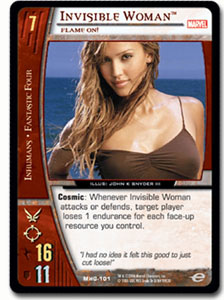 I’m sure there’s some joke that I could make about our 7-drop, Invisible Woman, Flame On!, being the “hottest” version of Invisible Woman to date. Still, we are not concerned with any of Invisible Woman’s attributes other than those that relate to her effectiveness in our build. Fortunately, Invisible Woman fits the bill perfectly here, as her effect will generally be good for at least 7 endurance loss. If we have the initiative on turn 7, the Invisible Woman can make the situation for our opponents quite uncomfortable to say the least.
I’m sure there’s some joke that I could make about our 7-drop, Invisible Woman, Flame On!, being the “hottest” version of Invisible Woman to date. Still, we are not concerned with any of Invisible Woman’s attributes other than those that relate to her effectiveness in our build. Fortunately, Invisible Woman fits the bill perfectly here, as her effect will generally be good for at least 7 endurance loss. If we have the initiative on turn 7, the Invisible Woman can make the situation for our opponents quite uncomfortable to say the least.
Our final character—an 8-drop—is our last resort. If we run afoul of a late-game deck that prevents us from dealing significant damage in the early turns, then we at least have the comfort of knowing that Black Bolt, Devastating Decree will rend our opponent’s board asunder. Considering that we will almost always have a fully face-up resource row, Black Bolt turns a simple stun into a board-clearing event. One single attack can eliminate all but the hardiest characters on turn 8. Maybe it’s overkill, but I really like our chances for victory with the mighty mouth of Black Bolt in the endgame.
Let’s move on to our locations now. Some of the locations we have already discussed in some detail. First and foremost are four copies of The Substructure. This card is reminiscent of cycling locations like Clocktower and Lexcorp. However, The Substructure also benefits us by allowing us to cycle Inhumans character cards out of our resource row without having to worry about losing them forever to the KO’d pile. If we want them back, we can simply pitch a card to return our Inhumans characters to our hand.
On its own, The Substructure would be a fine card for our deck. However, The Substructure becomes absolutely phenomenal when we use it in unison with Attilan. Consider the following: Attilan has the potential to put any card from our deck on top of the deck, and The Substructure has the ability to put a card from the top of our deck into our resource row. If we merge those together, we realize that the combo of Attilan and The Substructure can put any card into our resource row. Considering the ease of setting up such a combo for our deck, this is absolutely phenomenal. If we decide that we need access to a certain location or plot twist, we can use our combo to get it into play immediately. If we need to search out a character card, we can put it into our resource row then move the character into our hand using a terraform location (or recruit it if it is a reservist). Suffice to say, Attilan is amazing . . . if we can keep it working effectively!
Since we’re on the topic of terraform locations, let’s discuss a few that we’d like for the deck. One very apparent choice is Blue Area of the Moon. While maybe not very powerful as an attack pump, Blue Area of the Moon is quite subtle because it allows for at least one attack per turn where our attacker won’t become stunned. This can be very useful with our hidden characters, especially Maximus the Mad, who has an inordinately low DEF for his cost. With Blue Area of the Moon, Maximus can swing away without having to worry about the repercussions of stunbacks.
Since we’ll have several hidden Inhumans characters in our deck, it would probably make sense to have a copy of Himalayan Enclave in our build. If we encounter an opponent who tries to bring our hidden characters to the visible area with an effect like No Man Escapes the Manhunters, we can counter the effect by using Himalayan Enclave to return our character to the hidden area. Granted, this ability won’t stop effects that allow opposing characters to attack into the hidden area; but Himalayan Enclave helps out in some small capacity there as well by giving all of our hidden characters +1 DEF. It’s not much, but it can certainly make a difference in a close game.
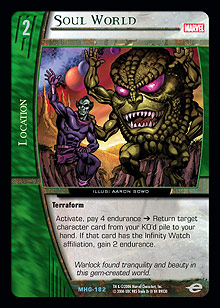 Our final terraform location is Soul World. To be fair, a location like Slaughter Swamp or Avalon Space Station would probably be better suited to the deck, as we should have little problem maintaining our hand. However, the terraform mechanic makes Soul World a better choice overall for our deck, as we can also use it to repair our resource row. We will probably find that we won’t want to use Soul World more than once or twice in any game, as the endurance payments can become pretty steep. Still, we may occasionally find it necessary to recur a key character card in the later turns. In that regard, Soul World is a logical choice for our deck’s recursion location.
Our final terraform location is Soul World. To be fair, a location like Slaughter Swamp or Avalon Space Station would probably be better suited to the deck, as we should have little problem maintaining our hand. However, the terraform mechanic makes Soul World a better choice overall for our deck, as we can also use it to repair our resource row. We will probably find that we won’t want to use Soul World more than once or twice in any game, as the endurance payments can become pretty steep. Still, we may occasionally find it necessary to recur a key character card in the later turns. In that regard, Soul World is a logical choice for our deck’s recursion location.
Our last location is a backup team-up in the form of Stormfront-1. We will rarely want to make this location our preferred team-up, as Extended Family is far more useful. However, we will sometimes find that we won’t want or be able to recruit Crystal, Elementelle on turn 3 to find our team-up. In these rare situations, we may actually want to use San on the prior turn to find Stormfront-1 for our team-up. At the very least, it fills the role of bringing our two primary teams together. The extra card that we draw from the effect of Stormfront-1 is just a bonus!
We’ve already discussed some of our plot twist choices. Let’s quickly reiterate the key plot twists: Our primary team-up is, of course, Extended Family. It certainly fills the role of team-up for the deck. It also accounts for something more in our deck, as the effect of adding a cosmic counter can immediately make characters like Wolverine and Karnak extraordinary. Even if we are already teamed-up, there’s a high likelihood that we will want to hoard extra copies of Extended Family if we have any of our powerful cosmic characters in play.
Another card that we mentioned earlier is Enemy of My Enemy. To be fair, there are several choices that we could make for the deck’s character searcher. The Great Refuge fits very nicely into the theme, and Marvel’s Most Wanted could search for any card in the deck. However, given that there would probably already be competition for space in the resource row, and that discarding multiple characters can be a strain on hand size, Enemy of My Enemy was chosen simply because it was the most versatile at filling the role for this particular build. Of course, opinions on this matter may vary.
Let’s consider the issue of attack pumps. We already have a nifty combat trick in the form of Blue Area of the Moon, but this location won’t actually help us with boosting the ATK values of our characters. The good news is that most of our characters already have ATK values much higher than the average characters at their costs. Moreover, characters like Meteorite and Wolverine have the ability to naturally attack up the curve. Thus, our attack pumps need not be excessive; rather, they can provide reasonable stat boosts that enhance other aspects of our characters’ attacks. One such card is It’s Slobberin’ Time!. This pump is not quite as friendly as its namesake (It’s Clobberin’ Time!), but considering that our entire theme revolves around having a face-up resource row, we should almost always be able to gain the additional +3 ATK from the plot twist. In essence, It’s Slobberin’ Time is functionally the same +3 ATK / +3 DEF as its Fantastic Four counterpart.
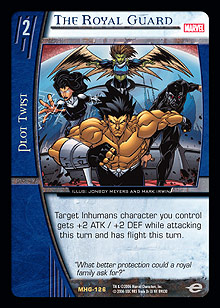 Another useful pump we’ll play is The Royal Guard. As far as pure attack power goes, The Royal Guard is a far cry from Savage Beatdown or Armageddon, but it serves its purpose well enough in our deck. First, it is a turn-based pump, meaning that the target character gets the boost from the plot twist anytime it attacks that turn. For characters like Quicksilver who can attack multiple times in a turn, such a pump is worth far more than a single attack boost. Secondly, The Royal Guard gives a balanced boost to both ATK and DEF. This not only enables attacking up the curve, but it can also prevent stunning back in many situations. Given the numerous cards that we have included to facilitate attacks without stunning back, this would seem to fit the theme of the build quite nicely.
Another useful pump we’ll play is The Royal Guard. As far as pure attack power goes, The Royal Guard is a far cry from Savage Beatdown or Armageddon, but it serves its purpose well enough in our deck. First, it is a turn-based pump, meaning that the target character gets the boost from the plot twist anytime it attacks that turn. For characters like Quicksilver who can attack multiple times in a turn, such a pump is worth far more than a single attack boost. Secondly, The Royal Guard gives a balanced boost to both ATK and DEF. This not only enables attacking up the curve, but it can also prevent stunning back in many situations. Given the numerous cards that we have included to facilitate attacks without stunning back, this would seem to fit the theme of the build quite nicely.
Now let’s consider a medium to utilize our attack tricks. We just discussed how the ability to attack more than once in a turn is quite powerful. With the Inhumans team, we are given a way to make this happen for any of our characters with Exploiting the Flaw. Our big beaters can take down most opposing drops without having to suffer stunbacks thanks to our combat tricks. This leaves our smaller hidden characters like Dallas Riordan, Mayoral Aide and San free to declare attacks on our opponent’s other characters. We can then use Exploiting the Flaw to transfer the attack to one of our bigger non-stunned characters like Meteorite or Hawkeye. The result is that our big characters get to effectively attack multiple times in a turn. Against any deck, this can be a powerful tool for gaining massive board advantage.
Our final card for the deck is our “recharge” card, so to speak. We will usually find that our resource row is stocked with locations and ongoing plot twists that are constantly useful to us. However, we may occasionally find that a wayward non-ongoing plot twist or character card has made its way into our all-important resource row. In such a situation, a quick terraform or activation of The Substructure may not be enough, so we’re going to play a single copy of Final Decree. This card is not to be used lightly, as it can potentially wreck our resource row. On the other hand, it can be very nice for replacing non-ongoing plot twists (that are sitting otherwise dead in the row) with cards that we can make use of in later turns. It is a risk, as replacing too many resources could put us in a position that we cannot recover from.
We’re done! The Inhumans and Thunderbolts have done their darndest to give us a face-up resource row. Let’s take a look at the build so we can evaluate their efforts:
The Promise of Greatness (60 cards)
Characters (29)
4 Dallas Riordan, Mayoral Aide
4 Quicksilver, Inhuman by Marriage
4 San, The Alienated One
4 Crystal, Elementelle
1 Kang, Kang Cobra
1 Wolverine, Skrunucklehead
4 Karla Sofen ◊ Meteorite, Celestial Power
1 Hawkeye, Leader by Example
1 Karnak, the Shatterer
2 Genis-Vell ◊ Photon, Transformed
1 Maximus the Mad, Mental Manipulator
1 Invisible Woman, Flame On!
1 Black Bolt, Devastating Decree
Plot Twists (19)
4 Enemy of My Enemy
4 Exploiting the Flaw
4 Extended Family, Team-Up
1 Final Decree
2 It’s Slobberin’ Time!
4 The Royal Guard
Locations (12)
3 Attilan
2 Blue Area of the Moon
1 Himalayan Enclave
1 Soul World
1 Stormfront-1, Team-Up
4 The Substructure
I daresay that the deck’s mulligan should be for The Substructure or San (who can fetch The Substructure). Aside from the interaction with Attilan discussed above, The Substructure is a powerful enabler just in the fact that it helps us cycle through an extra card each turn. With several terraform locations in the deck, we can afford to be a bit reckless with our activations of The Substructure. Even if we drop nothing but characters into our resource row, we should still have little problem getting Attilan online by turn 4 and making Meteorite a massive 9 ATK / 8 DEF.
Against an off-curve or press deck, even initiatives are usually preferable, as Maximus the Mad can set the stage for several massive unreinforceable attacks on turn 6. On the other hand, slower decks might require odd initiatives to allow for the extra damage available through Invisible Woman. In any situation, reaching turn 8 with Black Bolt in play will usually be a board-clearing experience.
And that does it for us, folks. Take care, and we’ll see you back here next week!
*Though I seem to remember someone telling me that she went back to being a villain after her stint on the Thunderbolts. Well, at least she tried . . .
Michael Barnes (AKA BigSpooky) is an avid Vs. System player who is a founding member of Team Alternate Win Condition (TAWC). When he isn’t concocting crazy deck ideas that no sane person would think of, he occupies his spare time working as an accountant in Dallas,TX. Any questions, comments, suggestions, or promises of greatness that you might have for Michael can be sent to him at BigSpooky1@hotmail.com.